A Flexible Demand Response Dispatch Strategy Considering Multiple Response Modes and Wind Power Uncertainty
Abstract
:1. Introduction
2. Multiple Response Characterization and Modeling of DR Resources
2.1. Multi-Response Characteristics of DR Resources
2.2. DR Resource Scheduling Decision Model
3. DR Resource Allocation Strategy Based on Multiple Response Modes
3.1. Scenario Generation and Reduction Models Considering Wind Uncertainty
- Step 1: Set a set of scenarios as the initial set and make as an empty set. Set the initial iteration number = 0.
- Step 2: Calculate . Each iteration needs to determine the deleted scenario, for example, the kth iteration needs to delete the scenario . Calculate the probability distance between the reserved scenario and , and obtain the scenario with the smallest probability distance , so that its probability is as follows:
- Step 3: Repeat Step 2 until the scenarios with the smallest distance from the deleted scenario set have been found and add them to achieve the goal that the expected number of deleted scenarios is the same as the number of deleted scenarios.
3.2. DR Resource Allocation Model Based on Multiple Response Modes
- The spinning reserve constraint:
- System network security constraint
- Power balance constraint
- Stability constraint
- The upper and lower limits of the output constraint
- The minimum startup/shutdown time constraint
- The ramping constraint
- The maximum startup and shutdown power constraint
- Constraints of DR resources in Equations (6)–(9).
4. Example Analysis
- The basic system dispatch without any DR participation.
- Impact of DR (with multiple response modes) on system dispatch.
- Impact of DR on system dispatch cost and wind power consumption.
- The flexible dispatch of DR resources reduces the cost due to the frequent startup and shutdown costs of thermal units.
- The reduction in peak load decreases the pressure on peak load regulation of thermal units.
- The improved wind power consumption level and the participation of DR resources reduce the high cost of wind curtailment penalty.
5. Conclusions
- Multiple DR integration has a notable impact on power system dispatch. Meanwhile, when coordinated with thermal units, DR effectively improves the function of peak shaving and valley filling;
- This flexible DR dispatch strategy provides a quantitative assessment of DR integration impacts on system operation cost and wind power consumption;
- It can be applied in day-ahead power system dispatch to help operators effectively evaluate the system state and design demand response mechanisms.
Author Contributions
Funding
Institutional Review Board Statement
Informed Consent Statement
Data Availability Statement
Conflicts of Interest
Appendix A
| Line ID | Line Impedance/Ω | Line Capacity/MW | Line ID | Line Impedance/Ω | Line Capacity/MW |
|---|---|---|---|---|---|
| 1–2 | 0.06 | 130 | 16–17 | 0.19 | 16 |
| 1–3 | 0.19 | 130 | 15–18 | 0.22 | 16 |
| 2–4 | 0.17 | 65 | 18–19 | 0.13 | 16 |
| 3–4 | 0.04 | 130 | 19–20 | 0.07 | 32 |
| 2–5 | 0.20 | 130 | 10–20 | 0.21 | 32 |
| 2–6 | 0.18 | 65 | 10–17 | 0.08 | 32 |
| 4–6 | 0.04 | 90 | 10–21 | 0.07 | 32 |
| 5–7 | 0.12 | 70 | 10–22 | 0.15 | 32 |
| 6–7 | 0.08 | 130 | 21–22 | 0.02 | 32 |
| 6–8 | 0.04 | 32 | 15–23 | 0.10 | 16 |
| 6–9 | 0.21 | 65 | 22–24 | 0.18 | 16 |
| 6–10 | 0.56 | 32 | 23–24 | 0.27 | 16 |
| 9–11 | 0.21 | 65 | 24–25 | 0.33 | 16 |
| 9–10 | 0.11 | 65 | 25–26 | 0.38 | 16 |
| 4–12 | 0.26 | 65 | 25–27 | 0.11 | 16 |
| 12–13 | 0.14 | 65 | 28–27 | 0.40 | 65 |
| 12–14 | 0.26 | 32 | 27–29 | 0.42 | 16 |
| 12–15 | 0.13 | 32 | 27–30 | 0.60 | 16 |
| 12–16 | 0.20 | 32 | 29–30 | 0.45 | 16 |
| 14–15 | 0.20 | 16 | 8–28 | 0.20 | 32 |
| - | - | - | 6–28 | 0.06 | 32 |
| Unit ID | Location Bus | Unit Operating Parameters | Maximum Output/MW | Minimum Output/MW | Initial Status | ||
|---|---|---|---|---|---|---|---|
| a | b | c | |||||
| 1 | 1 | 0.001 | 15.7 | 116.3 | 150 | 50 | 1 |
| 2 | 2 | 0.002 | 15.3 | 89 | 80 | 20 | 0 |
| 3 | 5 | 0.005 | 15.6 | 54 | 50 | 15 | 1 |
| 4 | 8 | 0.001 | 19.4 | 82 | 100 | 10 | 1 |
| 5 | 11 | 0.005 | 15.3 | 45.2 | 60 | 10 | 0 |
| 6 | 13 | 0.006 | 20.3 | 39.3 | 40 | 12 | 1 |
| Unit | Location Node | Minimum Downtime | Minimum Startup Time | Upward Ramping Rate | Downward Ramping Rate | Maximum Starting Power | Maximum Stopping Power |
| 1 | 1 | 3 | 2 | 30 | 30 | 80 | 70 |
| 2 | 2 | 0 | 0 | 16 | 16 | 35 | 35 |
| 3 | 5 | 3 | 3 | 12 | 12 | 30 | 30 |
| 4 | 8 | 4 | 3 | 20 | 22 | 55 | 45 |
| 5 | 11 | 0 | 0 | 13 | 12 | 40 | 30 |
| 6 | 13 | 3 | 3 | 10 | 10 | 30 | 20 |
| DR Resources Providers | Resource Number | Cost Coefficient | Maximum Response Duration/h | Maximum Response Capacity/MW | Minimum Response Capacity/MW |
|---|---|---|---|---|---|
| m1 | 9 | 6 | 15 | 5 | |
| D1 | m2 | 7 | 4 | 15 | 8 |
| m3 | 8 | 3 | 14 | 7 | |
| D2 | m4 | 11 | 5 | 15 | 7 |
| m5 | 14 | 4 | 10 | 5 | |
| DR Resources Providers | Resource Number | Maximum Response Number of Times | Minimum Response Interval time/h | — | — |
| D1 | m1 | 4 | 2 | — | — |
| m2 | 2 | 3 | — | — | |
| m3 | 3 | 2 | — | — | |
| D2 | m4 | 4 | 2 | — | — |
| m5 | 5 | 2 | — | — |
| DR Resources Providers | Resource Number | Cost Coefficient | Total Transferable Duration | Maximum Response Capacity | Minimum Response Capacity |
|---|---|---|---|---|---|
| D2 | J1 | 9 | 4 | 15 | 10 |
| DR Resources Providers | Resource Number | Maximum Load Level/mw | Minimum Load Level/mw | Tariff Response Upper Threshold/USD | Tariff Response Lower Threshold/USD |
|---|---|---|---|---|---|
| D3 | Z1 | 33 | 8 | 38 | 25 |

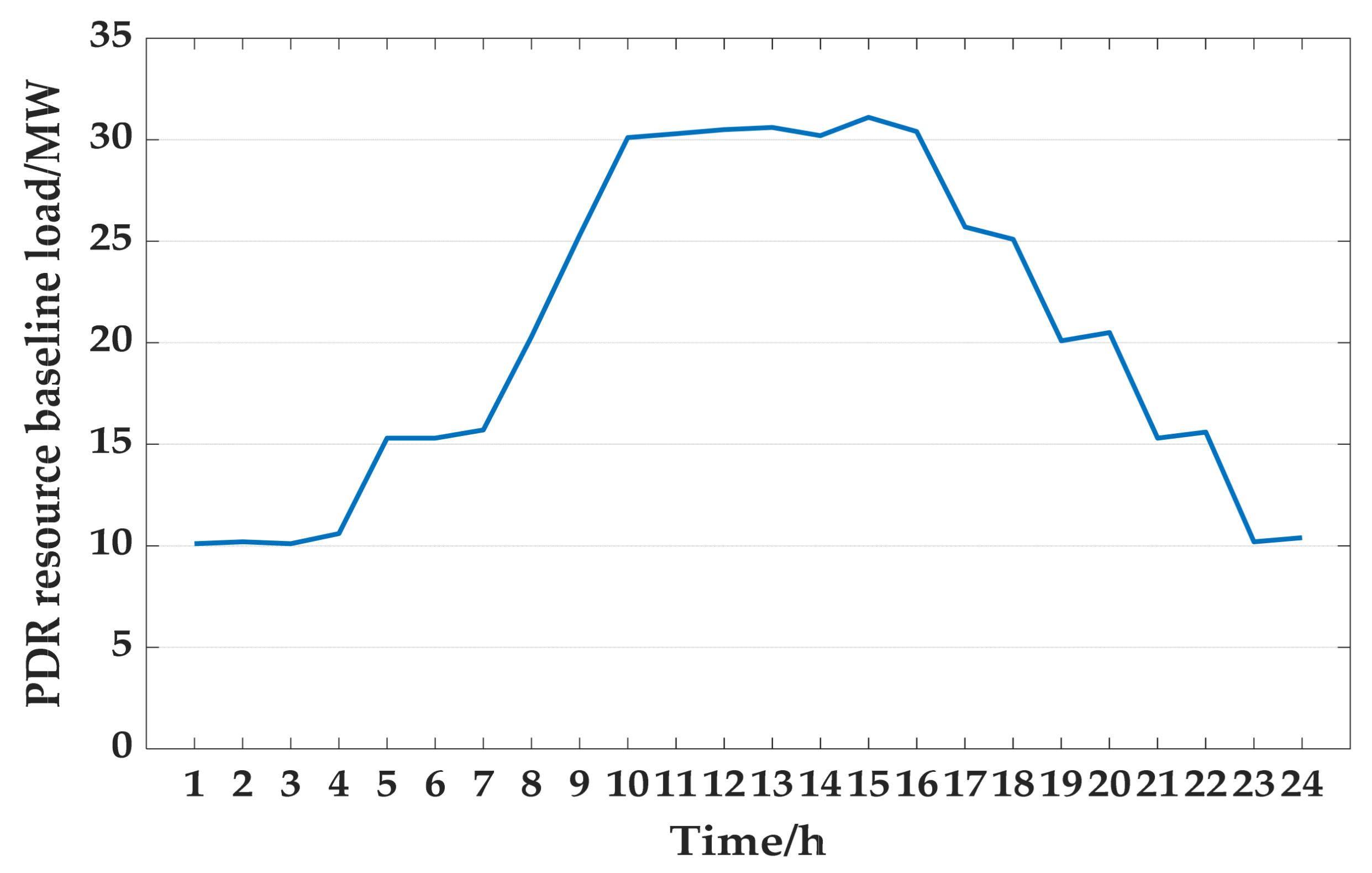
References
- Jordehi, A.R. Optimisation of demand response in electric power systems, a review. Renew. Sustain. Energy Rev. 2019, 103, 308–319. [Google Scholar] [CrossRef]
- Qdr, Q. Benefits of demand response in electricity markets and recommendations for achieving them. US Dep. Energy Wash. DC USA Tech. Rep. 2006, 2006, 73–75. [Google Scholar]
- Xiang, Y.; Cai, H.; Gu, C.; Shen, X. Cost-benefit analysis of integrated energy system planning considering demand response. Energy 2020, 192, 116632. [Google Scholar] [CrossRef]
- Lynch, M.Á.; Nolan, S.; Devine, M.T.; O’Malley, M. The impacts of demand response participation in capacity markets. Appl. Energy 2019, 250, 444–451. [Google Scholar] [CrossRef] [Green Version]
- Wang, X.; Huang, W.; Tai, N.; Shahidehpour, M.; Li, C. Two-stage full-data processing for microgrid planning with high penetrations of renewable energy sources. IEEE Trans. Sustain. Energy 2021, 12, 2042–2052. [Google Scholar] [CrossRef]
- Aghajani, G.R.; Shayanfar, H.A.; Shayeghi, H. Demand side management in a smart micro-grid in the presence of renewable generation and demand response. Energy 2017, 126, 622–637. [Google Scholar] [CrossRef]
- Ahmadi, S.E.; Rezaei, N. A new isolated renewable based multi microgrid optimal energy management system considering uncertainty and demand response. Int. J. Electr. Power Energy Syst. 2020, 118, 105760. [Google Scholar] [CrossRef]
- Zhao, H.T.; Zhu, Z.C.; Yu, E.K. Research on demand response market and demand response project in power market. Power Syst. Technol. 2010, 34, 146–153. [Google Scholar]
- Sun, Q. Application Research of Price-Based Demand Response Decision Optimization Model; North China University of Electric Power: Beijing, China, 2016. [Google Scholar]
- Lu, Q.; Zhang, Y. Demand response strategy of game between power supply and power consumption under multi-type user mode. Int. J. Electr. Power Energy Syst. 2021, 134, 107348. [Google Scholar] [CrossRef]
- Cui, Y.; Zhang, J.R.; Wang, Z.; Wang, T.; Zhao, Y.T. Day-ahead dispatching strategy for wind-light-thermal co-generation system with price-based demand response. Chin. J. Electr. Eng. 2020, 40, 3103–3114. [Google Scholar]
- Dou, X.; Wang, J.; Wang, Z.; Ding, T.; Wang, S. A decentralized multi-energy resources aggregation strategy based on bi-level interactive transactions of virtual energy plant. Int. J. Electr. Power Energy Syst. 2021, 124, 106356. [Google Scholar] [CrossRef]
- Tuan, L.A.; Bhattacharya, K. Competitive framework for procurement of interruptible load services. IEEE Trans. Power Syst. 2003, 18, 889–897. [Google Scholar] [CrossRef]
- Mohseni, S.; Brent, A.C.; Kelly, S.; Browne, W.N.; Burmester, D. Modelling utility-aggregator-customer interactions in interruptible load programmes using non-cooperative game theory. Int. J. Electr. Power Energy Syst. 2021, 133, 107183. [Google Scholar] [CrossRef]
- Aminifar, F.; Fotuhi-Firuzabad, M.; Shahidehpour, M. Unit commitment with probabilistic spinning reserve and interruptible load considerations. IEEE Trans. Power Syst. 2009, 24, 388–397. [Google Scholar] [CrossRef]
- Mansoori, A.; Fini, A.S.; Moghaddam, M.P. Power System Robust Day-ahead Scheduling with the Presence of Fast-Response Resources Both on Generation and Demand Sides under High Penetration of Wind Generation Units. Int. J. Electr. Power Energy Syst. 2021, 131, 107149. [Google Scholar] [CrossRef]
- Fan, S.; He, G.; Jia, K.; Wang, Z. A novel distributed large-scale demand response scheme in high proportion renewable energy sources integration power systems. Appl. Sci. 2018, 8, 452. [Google Scholar] [CrossRef] [Green Version]
- Jun, D.; Linpeng, N.; Shilin, N.; Peiwen, Y.; Anyuan, F.; Hui, H. A two-stage robust spinning idle capacity optimization model considering demand response and wind power uncertainties. Electr. Power Constr. 2019, 40, 55–64. [Google Scholar]
- Jin, S.; Botterud, A.; Ryan, S.M. Impact of demand response on thermal generation investment with high wind penetration. IEEE Trans. Smart Grid 2013, 4, 2374–2383. [Google Scholar] [CrossRef] [Green Version]
- Cordeiro, M.; Villanueva, D.; Eguía-Oller, P. Optimization of the Electrical Demand of an Existing Building with Storage Management through Machine Learning Techniques. Appl. Sci. 2021, 11, 7991. [Google Scholar] [CrossRef]
- Kong, X.; Quan, S.; Sun, F. Two-Stage Optimal Scheduling of Large-Scale Renewable Energy System Considering the Uncertainty of Generation and Load. Appl. Sci. 2020, 10, 971. [Google Scholar] [CrossRef] [Green Version]
- Niu, W.J.; Li, Y.; Wang, B. Demand response virtual power plant modeling considering uncertainty. Chin. J. Electr. Eng. 2014, 34, 3630–3637. [Google Scholar]
- Klobasa, M. Analysis of demand response and wind integration in Germany’s electricity market. IET Renew. Power Gener. 2010, 4, 55–63. [Google Scholar] [CrossRef]
- Doherty, R.; O’malley, M. A new approach to quantify reserve demand in systems with significant installed wind capacity. IEEE Trans. Power Syst. 2005, 20, 587–595. [Google Scholar] [CrossRef]
- Safdarian, A.; Fotuhi-Firuzabad, M.; Aminifar, F. Compromising wind and solar energies from the power system adequacy viewpoint. IEEE Trans. Power Syst. 2012, 27, 2368–2376. [Google Scholar] [CrossRef]
- Xin, A.; Shupeng, Z.; Qun, Z.R. Research on optimal scheduling model with interruptible load based on scenario analysis. Chin. J. Electr. Eng. 2014, 34, 25–31. [Google Scholar]
- Lei, Y. Research on the Unit Combination Problem of Power Systems Containing Wind Farms Based on Scenario Analysis; Shandong University: Jinan, China, 2013. [Google Scholar]
- Ding, T.; Lin, Y.; Bie, Z.; Chen, C. A resilient microgrid formation strategy for load restoration considering master-slave distributed generators and topology reconfiguration. Appl. Energy 2017, 199, 205–216. [Google Scholar] [CrossRef]
- Arroyo, J.M.; Conejo, A.J. Optimal response of a thermal unit to an electricity spot market. IEEE Trans. Power Syst. 2000, 15, 1098–1104. [Google Scholar] [CrossRef]
- Ademovic, A.; Bisanovic, S.; Hajro, M. A genetic algorithm solution to the unit commitment problem based on real-coded chromosomes and fuzzy optimization. In Proceedings of the Melecon 2010—2010 15th IEEE Mediterranean Electrotechnical Conference, Valletta, Malta, 26–28 April 2010; pp. 1476–1481. [Google Scholar]
- Niknam, T.; Narimani, M.R.; Jabbari, M. Dynamic optimal power flow using hybrid particle swarm optimization and simulated annealing. Int. Trans. Electr. Energy Syst. 2013, 23, 975–1001. [Google Scholar] [CrossRef]
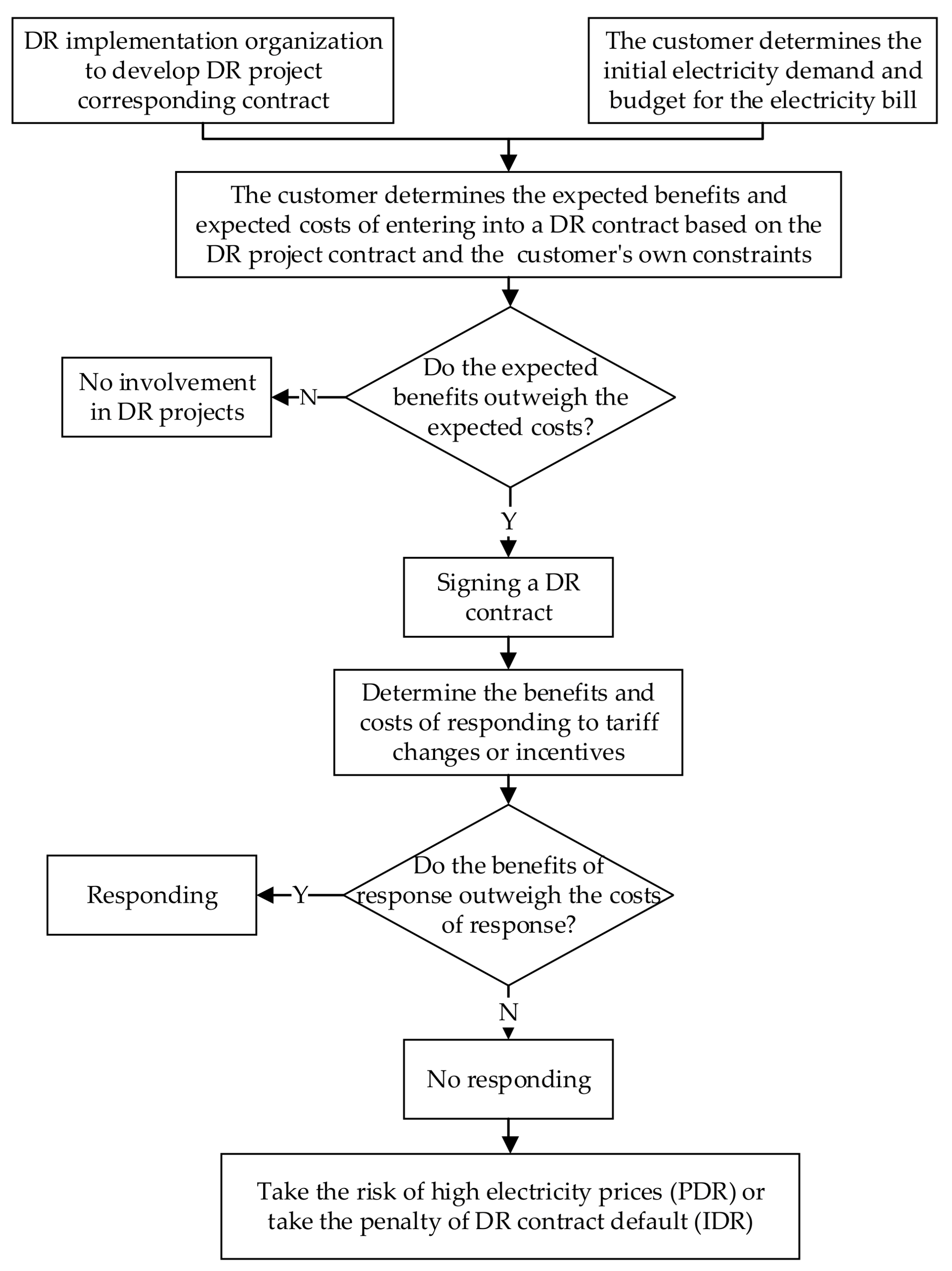

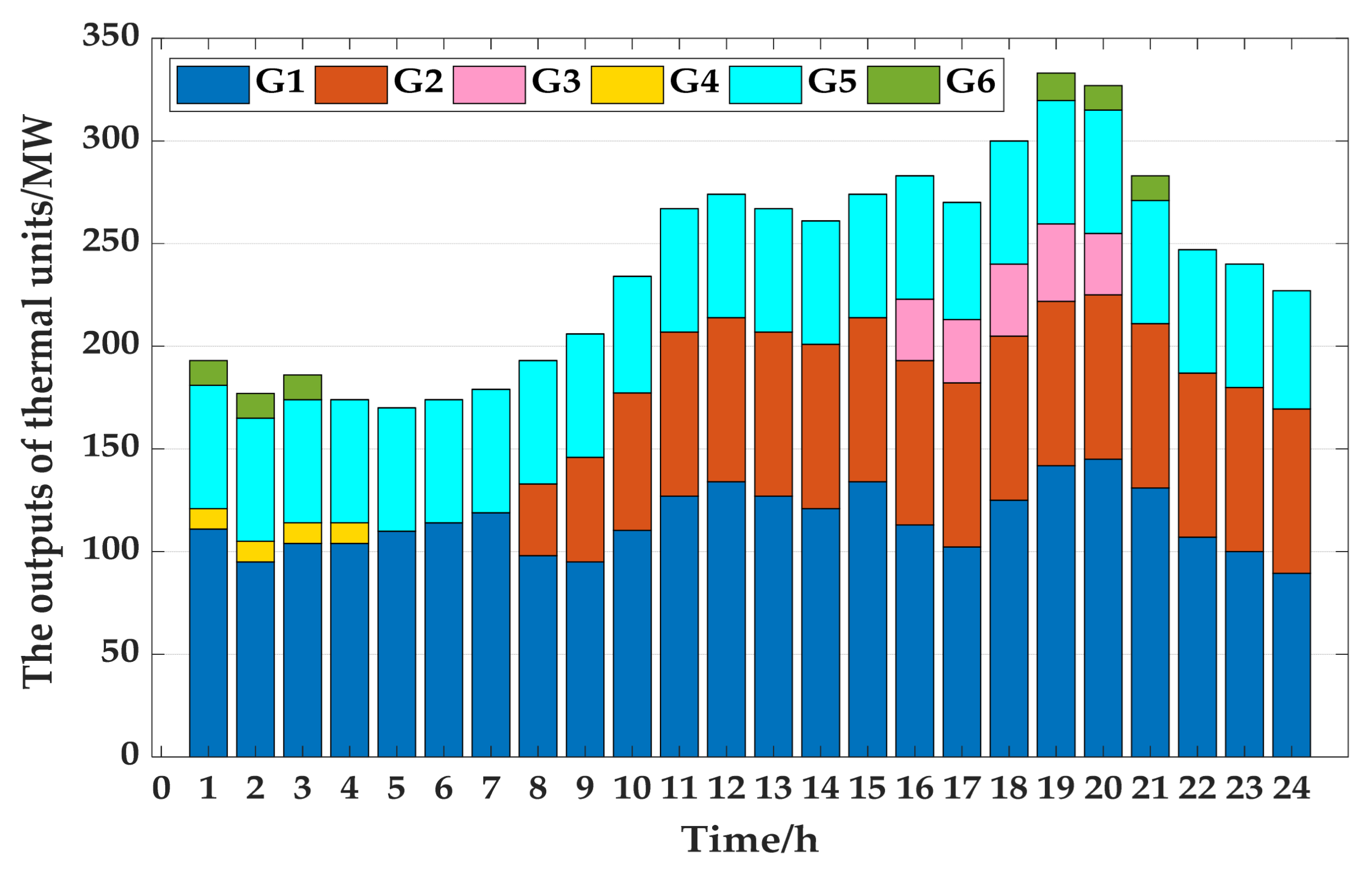
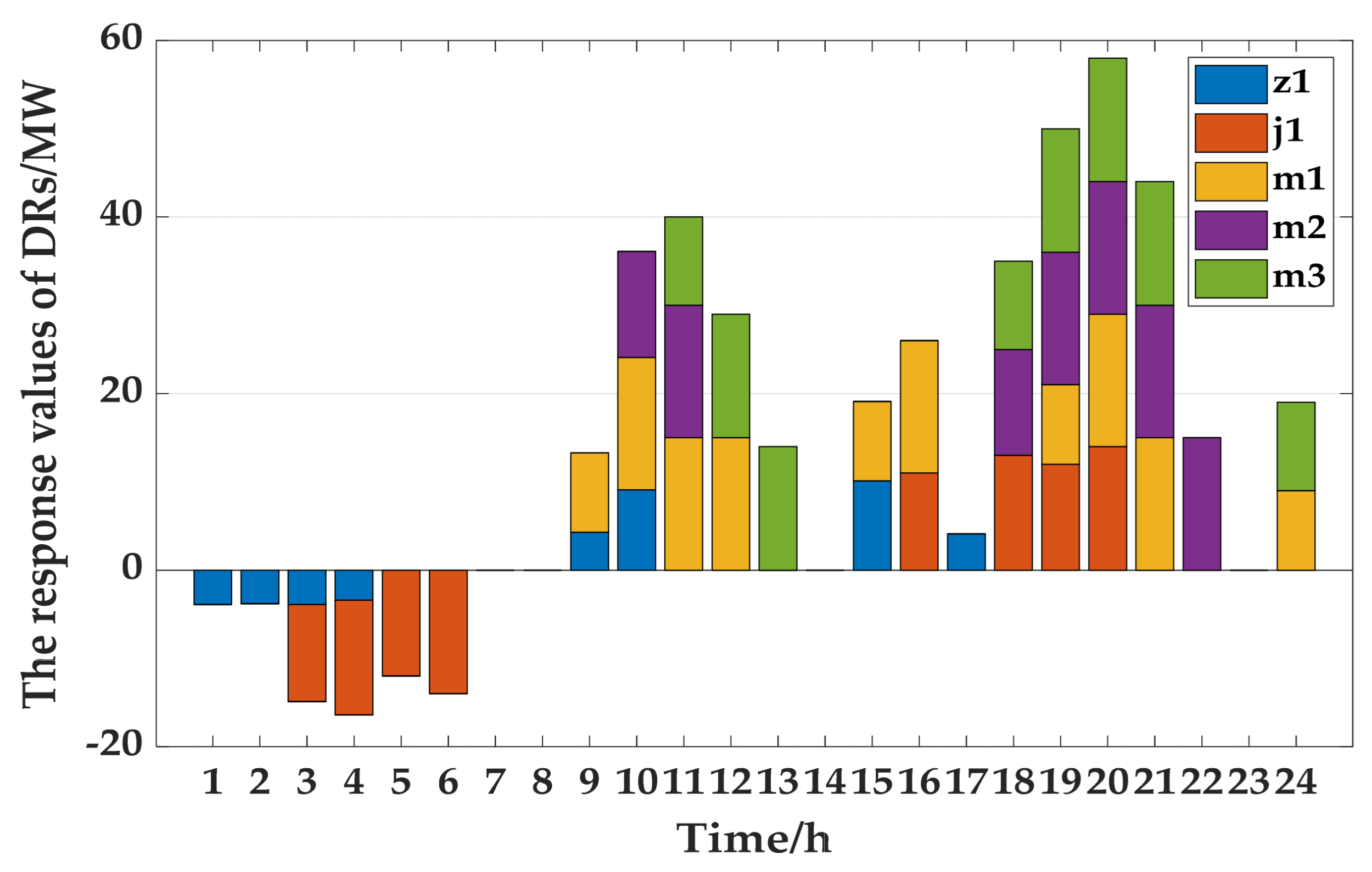

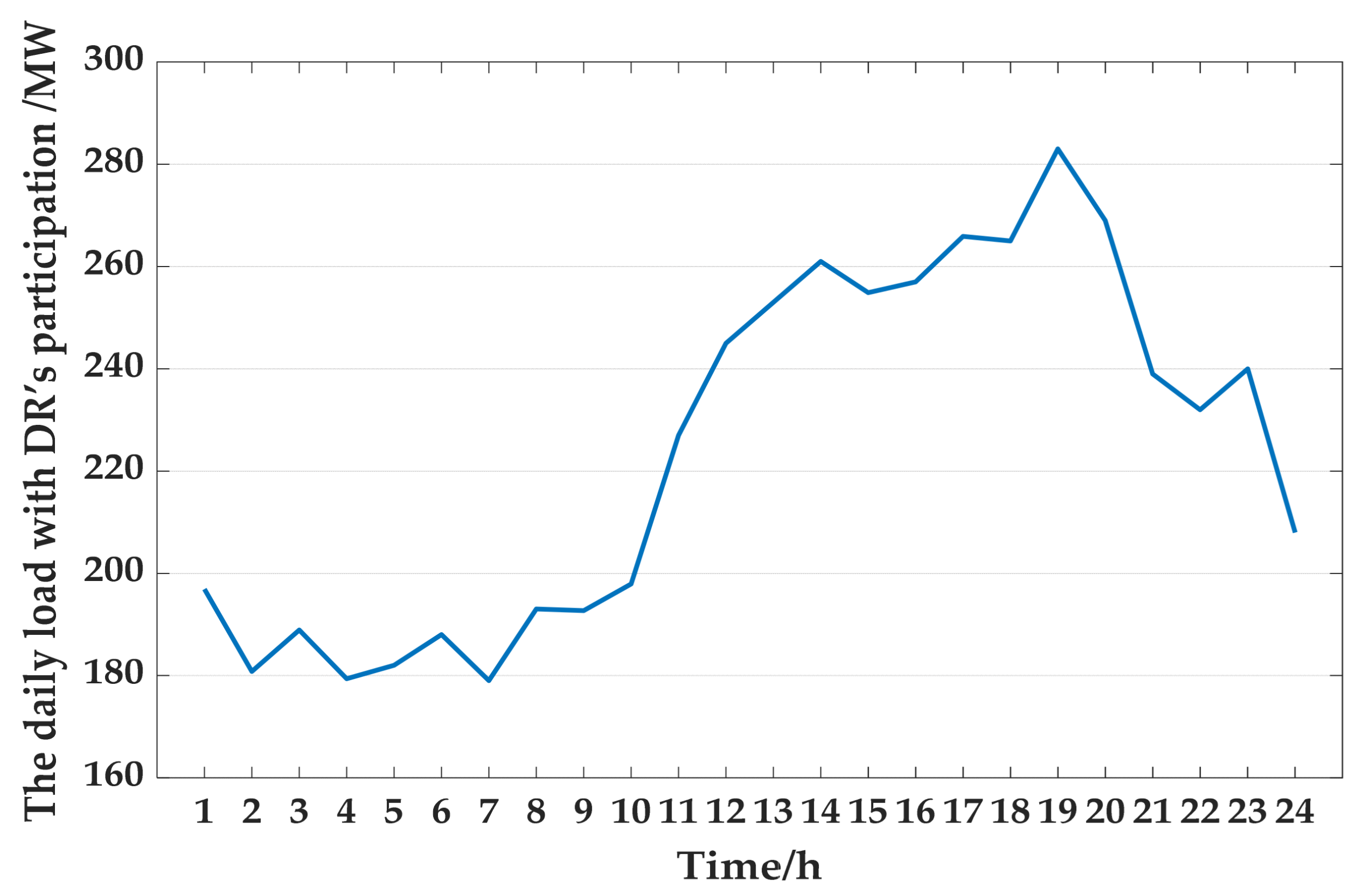
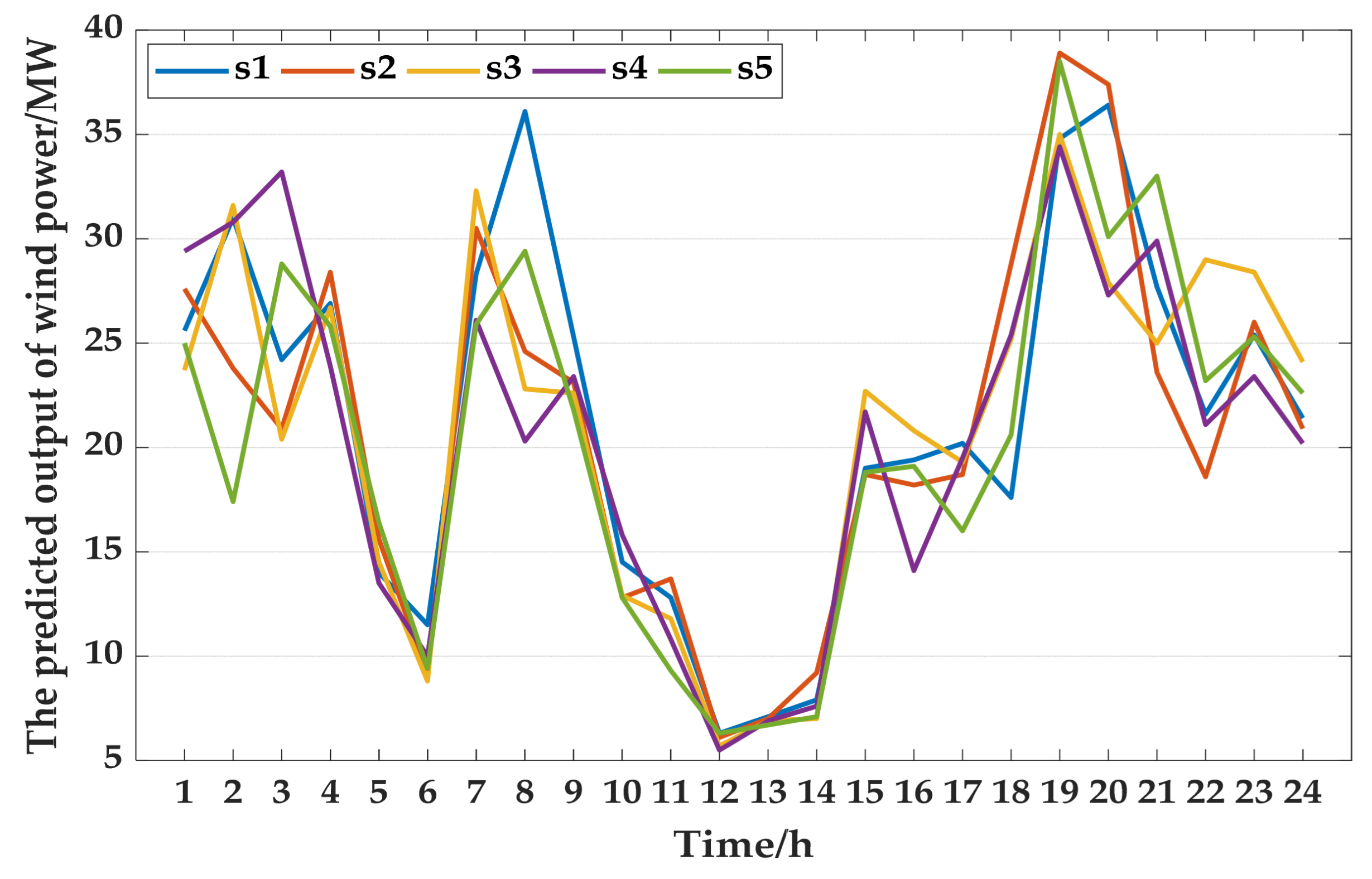
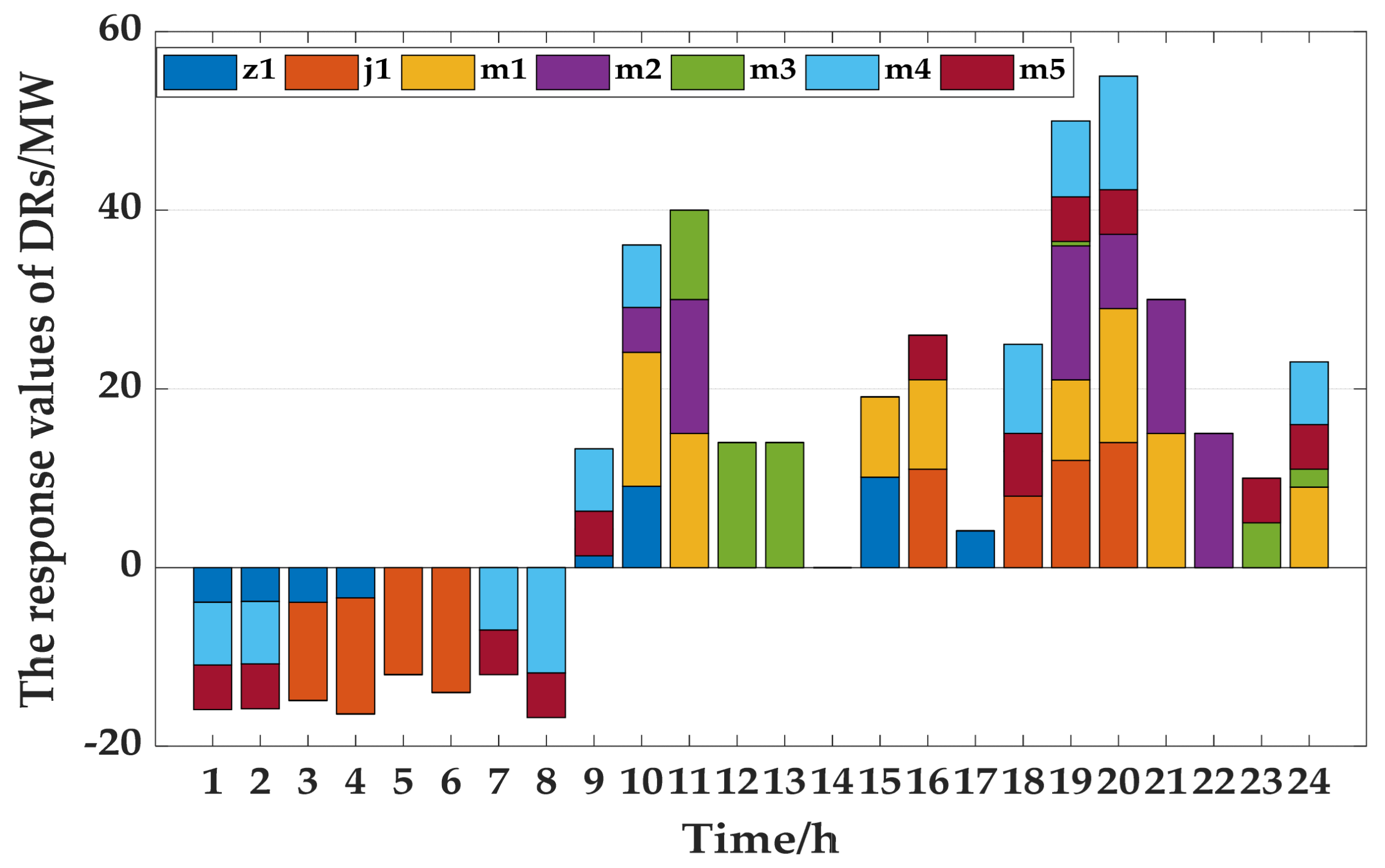
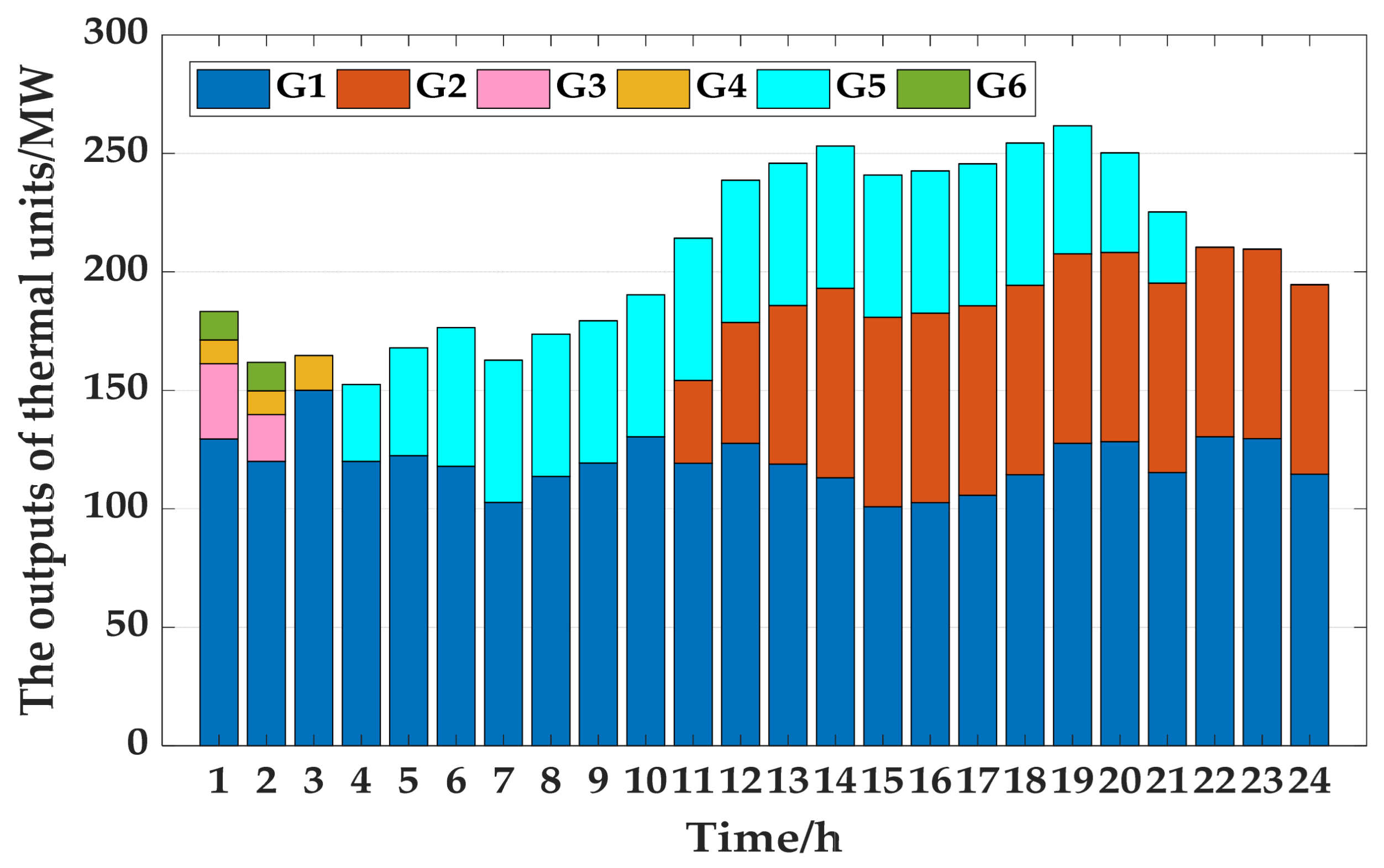

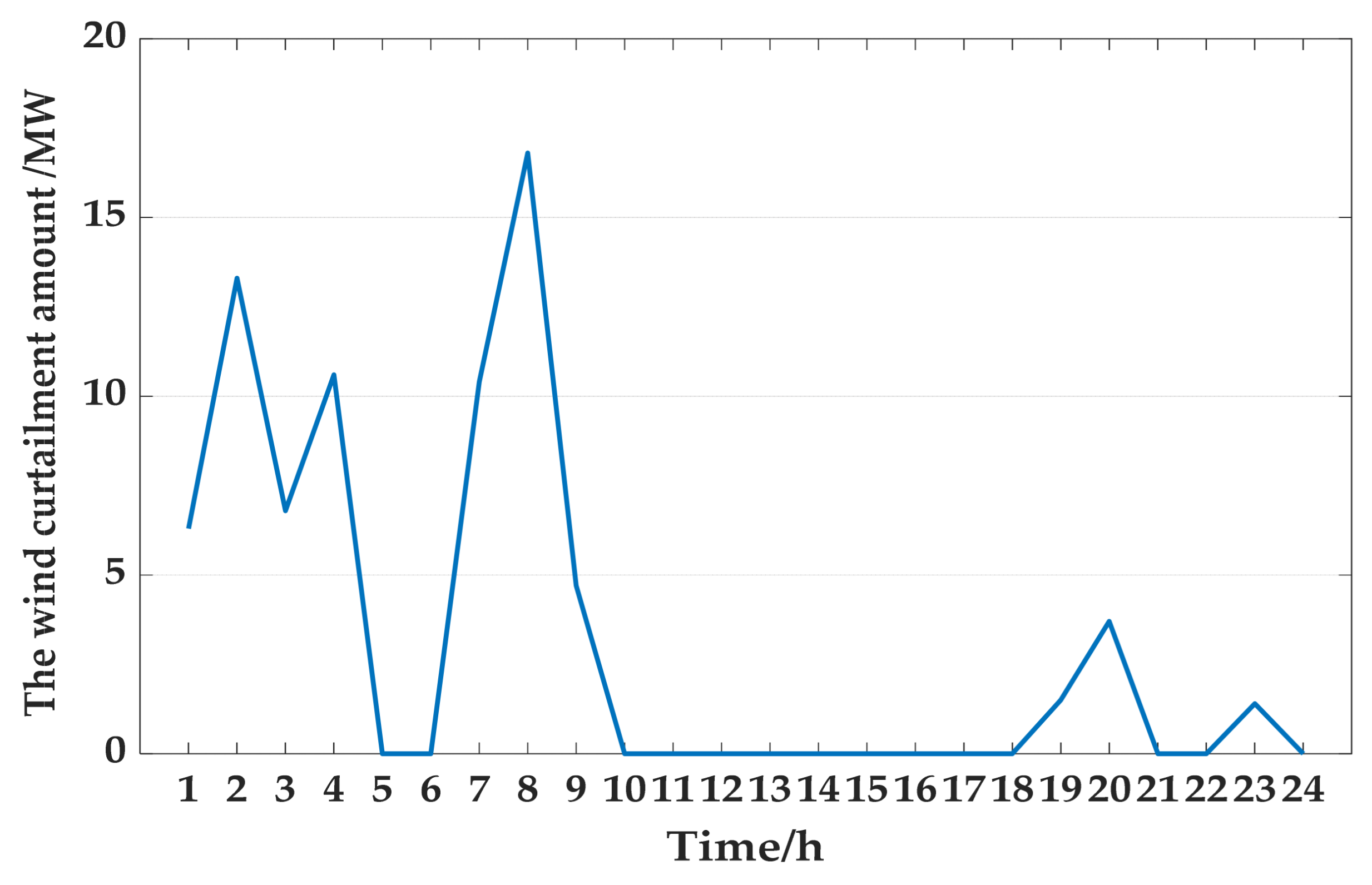
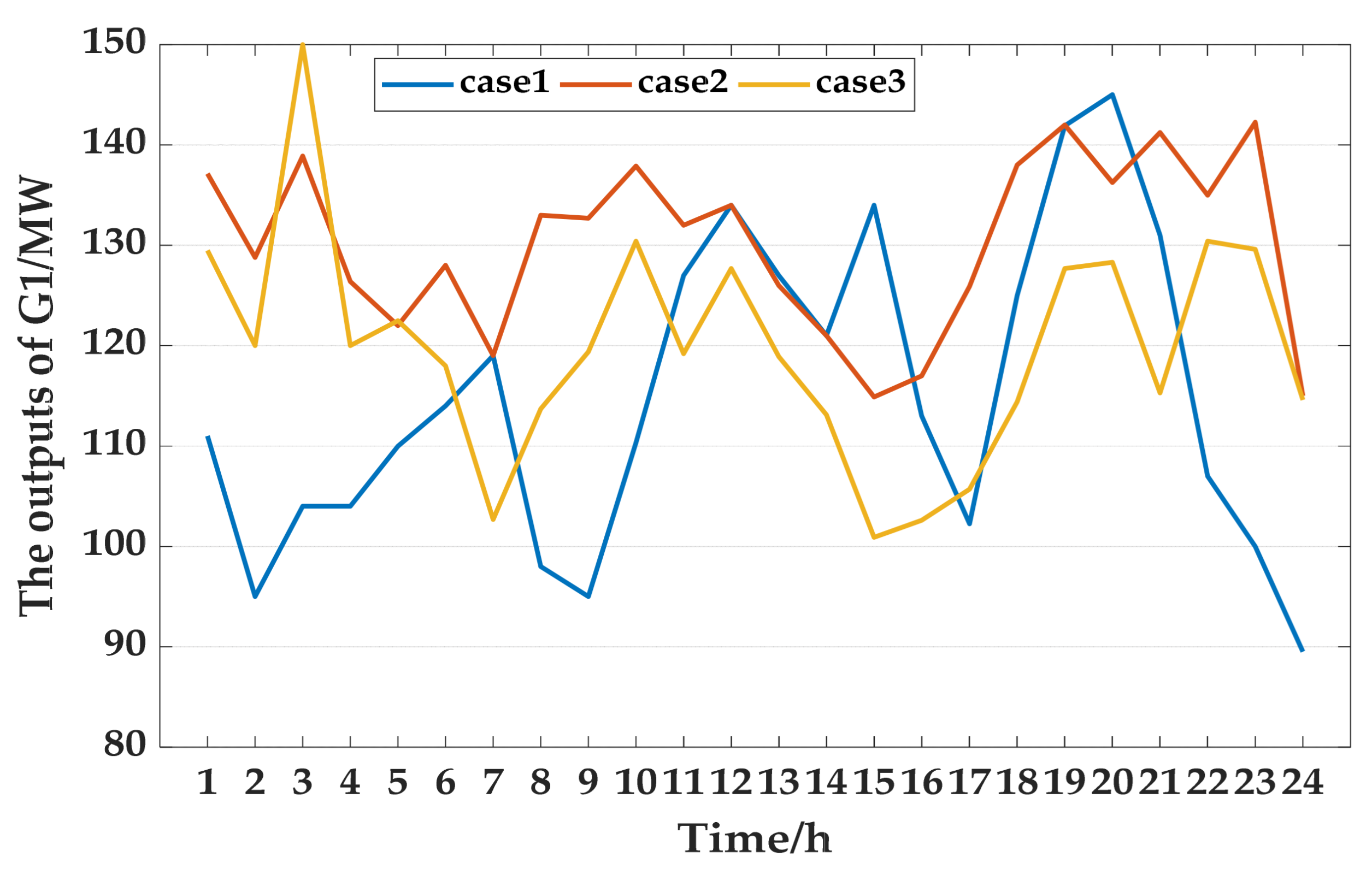


| ① | ② | |
|---|---|---|
| Response modes | Single response [1,2] | Multiple response [3,9] |
| Uncertainty sources | Intermittent energy [5,15] | Load forecast [6] |
| Response constraints | Response capacity [9] | Response time [14,17] |
| Response forms | Load shifting [4,7] | Load shedding [12,13] |
| Constraint Type | DR Resources | Thermal Units |
|---|---|---|
| Output constraint | Minimum response capacity Maximum response capacity | Maximum output Minimum output Ramping constraint |
| Time-dependent constraint | Minimum response interval time Maximum response amount Maximum response duration | Minimum offline hours Minimum online hours Startup/shutdown power constraint |
| Unit No. | Startup Time | Shutdown Time |
|---|---|---|
| 1 | ||
| 2 | 8:00 | |
| 3 | 16:00 | 21:00 |
| 4 | 5:00 | |
| 5 | ||
| 6 | 19:00 | 4:00, 22:00 |
| Unit No. | Startup Time | Shutdown Time |
|---|---|---|
| 1 | ||
| 2 | 11:00 | 21:00 |
| 3 | 19:00 | 3:00 |
| 4 | 4:00 | |
| 5 | 3:00 | |
| 6 | 3:00 |
| Scenario No. | S1 | S2 | S3 | S4 | S5 |
|---|---|---|---|---|---|
| Probability | 0.43 | 0.21 | 0.05 | 0.19 | 0.12 |
| Total Cost | Thermal Unit Operating Cost | Wind Curtailment Penalty Cost | Unit Startup/Shutdown Cost | DR Cost | |
|---|---|---|---|---|---|
| DRs participate | 96,322 | 89,013 | 6710 | 599 | 0 |
| DRs quit | 89,412 | 84,518 | 0 | 412 | 4842 |
Publisher’s Note: MDPI stays neutral with regard to jurisdictional claims in published maps and institutional affiliations. |
© 2021 by the authors. Licensee MDPI, Basel, Switzerland. This article is an open access article distributed under the terms and conditions of the Creative Commons Attribution (CC BY) license (https://creativecommons.org/licenses/by/4.0/).
Share and Cite
Han, H.; Zhang, Y.; Wei, T.; Zang, H.; Sun, G.; Wu, C.; Wei, Z. A Flexible Demand Response Dispatch Strategy Considering Multiple Response Modes and Wind Power Uncertainty. Appl. Sci. 2021, 11, 10165. https://doi.org/10.3390/app112110165
Han H, Zhang Y, Wei T, Zang H, Sun G, Wu C, Wei Z. A Flexible Demand Response Dispatch Strategy Considering Multiple Response Modes and Wind Power Uncertainty. Applied Sciences. 2021; 11(21):10165. https://doi.org/10.3390/app112110165
Chicago/Turabian StyleHan, Haiteng, Yao Zhang, Tiantian Wei, Haixiang Zang, Guoqiang Sun, Chen Wu, and Zhinong Wei. 2021. "A Flexible Demand Response Dispatch Strategy Considering Multiple Response Modes and Wind Power Uncertainty" Applied Sciences 11, no. 21: 10165. https://doi.org/10.3390/app112110165
APA StyleHan, H., Zhang, Y., Wei, T., Zang, H., Sun, G., Wu, C., & Wei, Z. (2021). A Flexible Demand Response Dispatch Strategy Considering Multiple Response Modes and Wind Power Uncertainty. Applied Sciences, 11(21), 10165. https://doi.org/10.3390/app112110165








